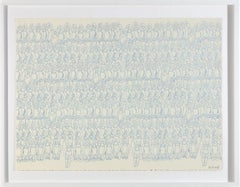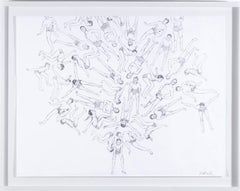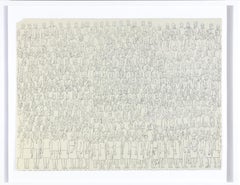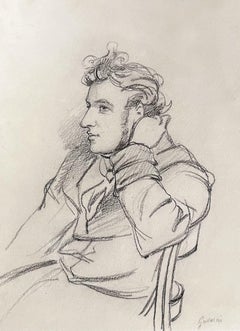Jay Alan Babcock Figurative Drawings and Watercolors
to
3
Overall Width
to
Overall Height
to
3
2
1
3
2
2
2
1
1
1
1
3
3
4
899
324
213
192
3
3
Artist: Jay Alan Babcock
Swim Team
By Jay Alan Babcock
Located in Saint Louis, MO
Jay Alan Babcock is a St. Louis-based graphic designer and painter. His work exhibits his interest in the visual language of Americana, including old ...
Category
2010s American Modern Jay Alan Babcock Figurative Drawings and Watercolors
Materials
Carbon Pencil
Divers
By Jay Alan Babcock
Located in Saint Louis, MO
Jay Alan Babcock is a St. Louis-based graphic designer and painter. His work exhibits his interest in the visual language of Americana, including old ...
Category
2010s American Modern Jay Alan Babcock Figurative Drawings and Watercolors
Materials
Carbon Pencil
Yearbook
By Jay Alan Babcock
Located in Saint Louis, MO
Jay Alan Babcock is a St. Louis-based graphic designer and painter. His work exhibits his interest in the visual language of Americana, including old ...
Category
2010s Contemporary Jay Alan Babcock Figurative Drawings and Watercolors
Materials
Carbon Pencil
Related Items
Paul Gavarni (1804-1866) Portrait of a young man, signed drawing
By Paul Gavarni
Located in Paris, FR
Paul Gavarni (1804-1866)
Portrait of a young man leaning on a Chair
Signed lower right
Black pencil on paper
23.7 x 17.6 cm
In good condition
Framed : 40 x 34 cm
This fine portr...
Category
1840s Romantic Jay Alan Babcock Figurative Drawings and Watercolors
Materials
Carbon Pencil
$1,155
H 9.34 in W 6.7 in
French School 19th Century, A Muskeeter, original pencil drawing
Located in Paris, FR
French school 19th Century
A Muskeeter
Pencil on paper
26.5 x 17 cm
Bears a signature "F. Roybet" in the lower right
In quite good condition, bears some visible foxings,
In an old mount (some damages)
(not framed)
Even if the style, execution and of course subject are those of Ferdinand Roybet...
Category
1890s Academic Jay Alan Babcock Figurative Drawings and Watercolors
Materials
Carbon Pencil
The Loving Couple
By Charles Angrand
Located in Paris, Île-de-France
Circle of Charles Angrand (1854-1926)
The Loving Couple
Pencil and stump on paper,
30 x 22 cm
Dated "10.4.19" lower left. Trace of a dedication
Otherwise unsigned.
Provenance:
Pr...
Category
1910s Post-Impressionist Jay Alan Babcock Figurative Drawings and Watercolors
Materials
Conté, Carbon Pencil
Academic Study for the Head of an Apostle or Saint
Located in Firenze, IT
Study for the Head of an Apostle or Saint
Artist: Enrico Reffo (1831-1917)
Medium: Charcoal and white chalk on colored paper
Dimensions: [To be specified]
Date: Late 19th - Early 20...
Category
Mid-19th Century Academic Jay Alan Babcock Figurative Drawings and Watercolors
Materials
Paper, Charcoal, Carbon Pencil
A Handsome 1940s Portrait of a Seated Man by Chicago Artist, Harold Haydon
By Harold Haydon
Located in Chicago, IL
A Handsome 1940s Portrait of a Seated Man by Chicago Modern Artist, Harold Haydon (Am. 1909-1994). A wonderfully executed line drawing dating from 1946 with great character; looks ...
Category
Mid-20th Century American Modern Jay Alan Babcock Figurative Drawings and Watercolors
Materials
Paper, Graphite
$135
H 20 in W 16 in D 0.13 in
Alfred Bendiner, Baccaloni in Rosenkavalier
By Alfred Bendiner
Located in New York, NY
The Italian opera singer, Salvatore Baccaloni (1900-1969) often took comic roles. He worked with several opera companies in Philadelphia between 1951 and 1966. Bendiner was a world t...
Category
Mid-20th Century American Modern Jay Alan Babcock Figurative Drawings and Watercolors
Materials
Gouache
A Humorous, Mid-Century Modern Cartoon Drawing, “Use Your Energy Constructively"
By Harold Haydon
Located in Chicago, IL
A Quirky, Humorous 1950s Mid-Century Modern Cartoon Illustration Ink Drawing by Notable Chicago Artist, Harold Haydon (Am. 1909-1994). Depicting a young man diligently working at a ...
Category
Mid-20th Century American Modern Jay Alan Babcock Figurative Drawings and Watercolors
Materials
Paper, Ink
$235
H 16 in W 12 in D 0.13 in
Alfred Bendiner, (Baseball Hitter and Pitcher -- The Philadelphia Phillies?)
By Alfred Bendiner
Located in New York, NY
Of course it's possible that these baseball players aren't from a Philadelphia team, but I doubt it. There was so much drama and intrigue with both the Philadelphia Phillies...
Category
Mid-20th Century American Modern Jay Alan Babcock Figurative Drawings and Watercolors
Materials
India Ink, Watercolor
Alfred Bendiner, Johnny Hodges (Johnny Hodges, Bass Fiddle & Traps)
By Alfred Bendiner
Located in New York, NY
Did Bendiner ever miss a performance, show, concert, play? Was there anyone he didn't know?
This double-side drawing in blue crayon shows Johnny Hodges (jazz saxophonist extraordina...
Category
1950s American Modern Jay Alan Babcock Figurative Drawings and Watercolors
Materials
Crayon
"The Lowest Pair" - Live Action Figurative Drawing of Musicians in Pencil
By Brian Rounds
Located in Soquel, CA
Dynamic live drawing of two musicians by Santa Cruz artist Brian Rounds (b. 1968). Drawn at a house concert in Santa Cruz, California, this piece depicts a musical duo called "The Lowest Pair," one playing guitar and the other one playing banjo. The composition skillfully captures a moment in time from the concert, showing the motion of the musicians.
Signed along the right edge.
Presented in a new grey mat with foamcore backing.
Mat size: 13"H x 15"W
Paper size: 6"H x 8.5"W
Brian Rounds (American, b. 1968) is an award-winning artist who grew up in the San Francisco Bay Area and is now based out of Santa Cruz, California. Since earning a B.A. in Painting from UC Santa Cruz, he has focused on a continued commitment to plein air painting in oils, but also enjoys working in watercolor and various drawing media.
His work has been shown at: Smith Gallery, UCSC; Pope Gallery, Santa Cruz; Santa Cruz Museum of Art and History; Winfield Gallery...
Category
2010s Contemporary Jay Alan Babcock Figurative Drawings and Watercolors
Materials
Paper, Carbon Pencil
$450
H 13 in W 15 in D 0.25 in
1940s Charcoal and Pencil Portrait of a Man
Located in Arp, TX
Artist Unknown
"Tie and Glasses"
c. 1940s
Charcoal and pencil on paper
13.5"x17" site 19"x23" rustic wood frame
Unsigned
Category
1940s Modern Jay Alan Babcock Figurative Drawings and Watercolors
Materials
Paper, Charcoal, Carbon Pencil
G A Rochegrosse (1859-1938) Study for the Exposition Internationale Paris 1900
By Georges Antoine Rochegrosse
Located in Paris, FR
Georges Antoine Rochegrosse (1859-1938)
A man sitted, Study for the decoration of the Salle des fêtes (Ballroom) of the Exposition Internationale, Paris 1900
Pencil and charcoal on thin yellow paper
29.5 x 20 cm
In acceptable condition : Tears and creases as visible on the photographs.
In a modern frame : 46 x 36.5 cm
Annotations on the back of the mount (now under the modern frame) that identifiy this drawing as a preparatory study for the decoration of the Salle des fêtes (Ballroom) of the 1900 Paris Exposition Internationale. It's also indicated that Henri Bataille...
Category
1890s Symbolist Jay Alan Babcock Figurative Drawings and Watercolors
Materials
Charcoal, Carbon Pencil
Jay Alan Babcock figurative drawings and watercolors for sale on 1stDibs.
Find a wide variety of authentic Jay Alan Babcock figurative drawings and watercolors available for sale on 1stDibs. You can also browse by medium to find art by Jay Alan Babcock in carbon pencil, pencil and more. Much of the original work by this artist or collective was created during the 21st century and contemporary and is mostly associated with the modern style. Not every interior allows for large Jay Alan Babcock figurative drawings and watercolors, so small editions measuring 35 inches across are available. Jay Alan Babcock figurative drawings and watercolors prices can differ depending upon medium, time period and other attributes. On 1stDibs, the price for these items starts at $2,450 and tops out at $2,450, while the average work can sell for $2,450.




